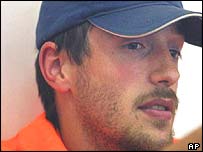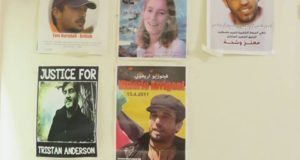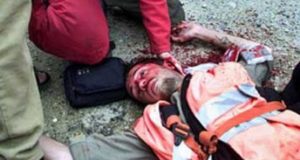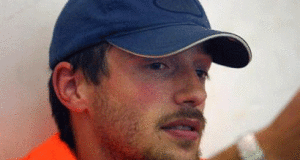BY Jocelyn Hurndal from The Sunday Times
March 18, 2007
After her son’s quest for answers led to his being gunned down, Jocelyn Hurndall faced a bitter battle with the Israeli army to get at the truth
It was the last day of term when Sophie, my daughter, called me at school. “Mum,” she said, “Tom’s been shot . . . The phone keeps on ringing . . . The Foreign Office called and they’re going to phone back . . . I think they said he was shot in a place called Rafah, in the Gaza Strip.”
I had been dreading such news since my 21-year-old son had left for Iraq two months before. That was February 2003, and the Iraq war had been about to start.
I dialled a number Sophie had given me, thinking it was the Foreign Office, but it was the Sunday Times news desk. I could hear a change in the voice of the journalist at the other end as he began to grasp who he was talking to.
“Look,” he said, “I’m terribly sorry. I’ll look on Reuters for you. But just be aware — when things first come through they’re not always accurate.”
I heard the click of the computer keys.
“What’s coming up,” he said slowly, “is that peace activist Tom Hurndall has been shot, and that he’s brain dead . . . But as I said, you really mustn’t believe everything you first hear.”
Heading home, I had driven barely 200 yards when my mobile rang. It was the journalist from The Sunday Times.
“Are you all right?” he said. “Please do drive carefully. How far do you have to go? Look, I live just near you, in Tufnell Park. Please let me know if there’s anything I can do to help.”
He was no longer wearing his journalist’s hat but speaking simply as one human being to another, and I could hear that he was genuinely concerned.
I tried to get hold of Anthony, my former husband, who was visiting Moscow. It was 3am Russian time before we had a desperate conversation. What had Tom been doing in the Gaza Strip? What had happened? We were determined to find out.
The first official Israeli version was that a Palestinian gunman wearing fatigues had been shooting at a watchtower and had been targeted by a member of the Israeli Defence Forces (IDF). But the story now coming to us was that Tom, unarmed and wearing a peaceworker’s fluorescent jacket, had been rescuing some Palestinian children from Israeli sniper fire and had been gunned down himself.
Around midnight I began phoning Israeli hospitals until finally the main hospital in Jerusalem suggested I call the Soroka in Beer-sheba. I was put through to its director.
“It’s not good news, I’m afraid,” he said. “He has a very, very serious head wound . . . He could last until tomorrow, or he could go in half an hour.”
“I’m coming. I’ll be on a plane in the morning.”
“Really,” he said, “I must emphasise how serious his condition is, Mrs Hurndall. Is it really necessary for you to come? If Tom dies your journey may be for nothing . . . And you know, he can be sent back.” I DOZED uneasily as the plane approached Tel Aviv. My head was filled with images of Tom lying injured; Tom as a baby, full of curiosity; six-year-old Tom, running naked round his grandmother’s croquet lawn in the pouring rain; Tom, single-minded and full of verve and mischief.
At 21, he was now the same age as I had been when I first went to Israel. I tried to reconcile this place where he was at death’s door with the place in which my father had developed a passionate interest and where I had spent two months of carefree work and travel.
My father had been a scientist with a mission — the generation of energy from wave power. He once told me how, when he was walking beside the Dead Sea, King Hussein of Jordan’s helicopter had landed nearby. My father had strolled over and struck up a conversation about alternative energy.
Just like Tom, I thought. Not much regard for formalities — just straight to the matter in hand. I knew, too, how painfully my father had struggled to reconcile his passionate interest in engineering with his Christian beliefs. That seemed like Tom, too — the idealism, the questioning, the independence — and the aloneness.
People didn’t always understand Tom’s thinking, and this was certainly true when he made up his mind to go to Iraq as a human shield in the war. Sophie, the first of my children, was protective of her three brothers. She had tried to dissuade him from going.
His journey to Baghdad didn’t — couldn’t — have my blessing, though I understood why he felt he must go. I was shocked, yet somehow resigned. When I hugged him as he left, all I could do was say, over and over: “Take care, Tom. Take care. Keep safe.”
We’d been here before — Tom was always challenging, always questioning. He wasn’t offering himself simply as a human shield. The reporter in him wanted to photograph and record for himself what the human shields were doing. He’d recently changed his course at Manchester Metropolitan University from criminology to photography. Tom photographed wherever he went.
We knew that he had left Iraq after it became clear that the authorities intended to use the volunteers to protect power stations rather than schools and hospitals. Tom wanted to prevent loss of life, but he wasn’t prepared to be a sitting target. The last we had heard he was helping in a refugee camp in Jordan.
MY hand was taken in a firm and reassuring grasp by a rather military-looking man with a kind and humorous expression.
“Mrs Hurndall? Tom Fitzalan-Howard. I’m the defence attaché, British embassy. Extremely good to meet you, but I’m sorry it’s in these circumstances. I hope you had a reasonable flight.”
Colonel Fitzalan-Howard, known as TFH, ushered me into a Range Rover. As we drove, we found we had acquaintances in common, including an old friend of mine now a general in the Royal Green Jackets.
I sensed that here was someone I could trust, a straight talker who was wholly unafraid to challenge immorality and untruth — someone who would want to do the right thing for the greater good and not just for his own country. As defence attaché, he said, he was the point of contact for all British diplomatic and consular matters involving the Israeli Defence Forces.
“You realise, don’t you,” he said, looking at me very directly, “that we’re not going to get anywhere with the Israelis.”
At first I didn’t understand. “All we want is to get at the truth. Doesn’t everyone?”
“It’s not quite as simple as that. They’re a hard-bitten lot. They’re not going to admit to anything. A lot of people have tried to call them to account, but I’m afraid they haven’t succeeded.”
To have this stated so starkly by someone so well informed was a shock.
“You know an Israeli soldier is not like a British soldier,” said TFH. “The concept of minimum force is central to a British soldier, who is trained, absolutely, to be accountable for his actions. The British rules of engagement are very strict on this, and they are always applied. It’s quite different with the IDF.
“For a start their soldiers are very young — conscripts mainly, though there are professional soldiers. The soldiers are invariably backed up by their commander and the chain of command.
“Jocelyn, I have to tell you” — here he spoke slowly as if for emphasis — “that the investigations are invariably a sham. This will be difficult for you and Anthony to deal with. A soldier is rarely held to account, and whatever he’s done he would never face a murder or manslaughter charge — he’d only be on a lesser charge, perhaps failing to carry out the correct drills. I really don’t want you to expect too much.”
He went on: “You also need to know that it’s only with political support at the highest level that we’ve achieved anything with any IDF investigations. Problem is that with media pressure alone they hunker down under the antisemitic charge, which they level against anyone who dares to criticise.”
This last comment hit home. The colonel’s words reminded me acutely of Tom’s Jewish friends and of the many Jewish people we knew in London. The present situation was not about race, religion, or getting sucked into any propaganda or political agenda. We wanted nothing but an objective search for truth, even if it meant believing that my pacifist son, Tom, really had dressed in army fatigues and been foolish enough to shoot at a watchtower, which was what the first absurd broadcast in Israel had stated.
I knew we were going to use every possible means to get at the truth, and I was sure the family would want to keep an open mind until we’d seen everything for ourselves. Anthony, as a lawyer, would be adamant about retaining objectivity and I knew he would not be hurried. IT was still not yet 8am when we reached the hospital and joined Anthony, who had flown in earlier and had already spoken to the doctors. We went up to the ward together.
I approached your bed and recognised your face in spite of the bandages round your dreadfully swollen head, covering your eyes . . . I was filled with terror at your absolute fragility and your uncertain future. I could not even pray.
Some of what Anthony was telling me as I stood there was hard to absorb. One senior doctor had suggested that Tom’s wound was “commensurate with a blow from a baseball bat”. Could any sane person connect these terrible injuries with a blow from a baseball bat? The notes at the foot of Tom’s bed clearly stated that he had suffered a “gunshot wound”.
Anthony had gathered that the consultant in charge had asked for an IDF doctor to visit Tom. What could all this mean? Uneasy already about the possibility of a cover-up, I began to feel the ground shifting under me. It seemed Tom was receiving the best medical care, but when it came to the medical evidence, to the politics of this situation, we both began to wonder who we could trust.
TFH said it was time to start for Rafah, which lay in the south of the Gaza Strip on the border with Egypt. Andy Whittaker, a British diplomat, led the way in another Range Rover: it was embassy policy always to go into the occupied territories in pairs.
“You never quite know what you’ll come up against,” TFH said with a laugh. “And by that I don’t mean any threat from the Palestinians. I’m much more worried by the IDF. I’m not saying it’s anything deliberate. More to do with lack of accountability and loose rules of engagement. It’s easy to be mistaken for someone else — even in an embassy Range Rover.”
Our first sight of Rafah was a dense cluster of watchtowers on the skyline. It seemed to be a ghost town. Whole streets had been demolished We were heading for the headquarters of an organisation TFH kept referring to as the ISM. The Range Rovers pulled up on a piece of waste ground. “Park round so we’re facing outwards,” I heard TFH say.
He shepherded us up some stairs into an almost bare room where people were waiting. I found it impossible to take in their names or much of what they were saying until a tall young man told me: “I am Mohammed. I was with Tom when he was shot . . . I met him first when he came here to the ISM headquarters.”
He said ISM was the International Solidarity Movement — “a peaceful movement, though the Israeli army and the Israeli press will tell you many lies about us. We try to stop the destruction of Palestinian homes, to monitor and bring attention to what is happening here”.
Mohammed said Tom had come to Rafah to find out what was happening after hearing about the death here of Rachel Corrie, an American student run over by an army bulldozer as she tried to stop it destroying a Palestinian house.
On the day of Tom’s shooting, said Mohammed, the ISM had intended to stage a peaceful protest by pitching a tent in the square outside the Rafah mosque, which was in an Israeli security zone and scheduled for demolition. They had cancelled the demonstration because of gunfire, which came either from one of the IDF watchtowers overlooking the square or from a tank parked outside the mosque.
They could see bullets ricocheting off a building beside a mound of rubble on which a group of about 20 or 30 children were playing, apparently accustomed to the danger.
Gradually the shots hit lower and lower, flying close over the children’s heads, and when they began scuffing up the sand, most of the children ran away. Only a boy and two little girls stayed rooted to the spot, crying for help.
Tom beckoned to the boy, holding out his arms, lifted him off the mound and carried him out of range of the shooting. Then he went back for the two little girls, bent down and put his arm round one of them.
“They shot him,” said Alice, an ISM member. “Right there. When he was rescuing those two children. The IDF shot him.”
She added: “He was wearing an orange jacket. We were all wearing orange jackets. Everyone recognises that means you’re a noncombatant.”
“Do you think it could have been a mistake?” I asked.
“A mistake? You don’t make mistakes with telescopic sights like the IDF have got. You could shoot the buttons off someone’s coat with those.”
“Was there any other shooting going on? Was there crossfire?”
“None. Absolutely none. There were no Palestinian gunmen in the area that day.”
It was time to see where Tom had been shot. The Palestinian Authority’s military police drove in front of us, tightly packed into a rickety-looking Jeep or hanging perilously off the sides and back. Dressed in black and heavily armed, they looked ominous.
“They shouldn’t have come,” Mohammed said. “They make the Israelis jittery.”
We got out near a square containing a crumbling mosque. Overlooking the square we could see the IDF watchtowers. In the middle of the street was a mound of sand-covered rubble and tangled iron girders, the customary IDF barrier made from the ruins of demolished houses. This was where the children had been playing.
There was blood on the ground and on a wall nearby. Anthony and I stood silently, utterly bereft. I pray that you suffered no pain, that the shot which entered your head and shattered your quick brain did so too swiftly for you to feel anything. Alice was silent and pale. I now knew from Mohammed that she had also been with Rachel Corrie when she died.
At our hotel later TFH handed me a black plastic bin-liner. “Tom’s clothes,” he said. “You’ll need to keep them as evidence.”
I began to remove the contents: first Tom’s cotton trousers, slashed up the sides where they must have been cut off him; his T-shirt, similarly cut; his orange fluorescent noncombatant’s jacket; his black photographer’s waistcoat with its many pockets. Everything stiff with blood.
I felt in the waistcoat pockets and pulled out the familiar cigarette lighter and a packet of Camels. How many hundreds of times in the past had I pulled mud-caked clothing out of plastic bags, felt in the pockets before putting them in the washing machine? It’s what mothers do, I thought. Yet now it was not mud.
I upended the bin-liner to make sure there was nothing left, and Tom’s watch fell out. A pang of the sharpest grief shot through me. I could see it on his wrist. He was never without it. DURING our second week in Israel, the British ambassador, Sherard Cowper-Coles, and his wife Bridget visited Tom. They had five teenage children of their own, all away at boarding school in England, and I could see that they were both deeply affected by the sight of Tom. Sherard stood at the foot of the bed with Anthony, silent and appalled.
Afterwards they invited us to dinner at a Chinese restaurant, where we relaxed a little. We told them we were getting nowhere in our attempts to meet the IDF, which had announced it was conducting an internal inquiry — a similar inquiry, we presumed, to the one that had completely exonerated the army over the death of Rachel Corrie.
Sherard’s manner was more measured and less forthright than TFH’s, but what he had to say about the IDF was hardly more encouraging.
“I’m afraid I really hold out very little hope of ever extracting a fully satisfactory account of what happened from them,” he said. “We may end up with some mild general admission of a mistake having been made. But that would be set in the context of the ISM being hostile to Israel and having no right to be there in the first place, plus the threat to the IDF in Rafah.
“However,” Sherard went on, “it doesn’t follow that we shouldn’t keep up the pressure for an account of what happened.”
He spoke with obvious sincerity, yet I had an uncomfortable feeling that, as far as the Foreign Office was concerned, the pass had already been sold. It seemed to be accepted that the Israeli army was a law unto itself.
Jack Straw, the foreign secretary, had metaphorically shrugged his shoulders in his first statement after Tom was shot, observing that the Foreign Office had been telling British nationals not to enter Gaza. While I recognised the need to discourage teams of people from entering the occupied territories and putting themselves and British diplomats at risk, it had seemed an inappropriate kind of statement to make directly after the shooting of a young man — and especially cold for someone with a son of almost the same age.
Bridget invited me to spend a few days at the ambassador’s residence in Tel Aviv, tactfully leaving me alone for most of the time to lie in the shade on the terrace outside my room. It was here I learnt of the death of a young British cameraman called James Miller, shot by the IDF as he filmed for a television documentary on the children of Rafah. According to Haaretz, the newspaper, James and his team had been carrying a white flag.
One evening Bridget and Sherard suggested going to a local bar to hear a well-known Israeli singer. I couldn’t do it. Just as well: a young British Muslim walked into a bar a few doors away from the one we would have visited and blew himself up, killing three people.
The British government was swift in its public condemnation. Yet it had not seen fit to make a public statement or put pressure of any kind on the Israeli government over its shooting of young British citizens. We made our outraged feelings clear to Sherard.
Only then did we receive a communication from Jack Straw, offering a meeting. The Foreign Office belatedly stated, almost a month after the incident, that it was “shocked and saddened” by Tom’s shooting and was “pressing the Israeli army for an investigation”.
Towards the end of May, Sherard received a copy of the Israelis’ field report into the shooting. It concluded: “It is impossible to establish with certainty the cause of the injuries sustained by Mr Hurndall . . . It is likely that Mr Hurndall was hit by IDF fire . . . The commander of the outpost acted according to the rules of engagement for the area: an armed Palestinian fired at an IDF soldier who felt an immediate danger and therefore he shot a single bullet in response.”
The document was accompanied by a “location map” that mistook the point where Tom was shot by about 80 yards. Did they really think we would be content with this level of investigation?
At a meeting with the IDF, we were confronted with massive evasions. When Anthony suggested that the field inquiry was a “cover-up”, the word went through the meeting like an electric shock.
The mood in Israel was changing, however. At hearings of the Israeli parliament’s law committee, Michael Eitan, an MP in Ariel Sharon’s Likud party, accused IDF soldiers of “gross violations of human rights” in the occupied territories. This, from a former army officer, caused a stir and focused new interest on Tom’s case.
Reporters surrounded us at Tel Aviv airport as we left to bring Tom home to London, unconscious on a stretcher, on May 29 — seven weeks after he was shot.
A young soldier in the security section pointed to our luggage. “We need to open your bags,” he said. I felt outraged. These soldiers knew what we’d been through, and they could see that we had embassy staff with us. The young soldier picked up a black bin-liner. Inside it was another bin-liner. He peered in but quickly closed it again.
It contained Tom’s bloodstained clothes. There had been no cool place to store them and by now the smell was horrific.
“What is in that bag?” he said. “Those are clothes belonging to my son, who was shot by one of your soldiers,” I said, looking at him with burning eyes. STRAW seemed disconnected when we met him in London; but he passed us on to Baroness Symons, minister of state at the Foreign Office. This was a very different kind of encounter.
Professional but extremely approachable, she was visibly moved by the details of Tom’s story. He was now in the Royal Free, our local north London hospital.
She wrote a letter to Silvan Shalom, the Israeli foreign minister, describing the evidence that Anthony had gathered about the shooting as “powerful and disturbing” and urging the need for the Israeli judge advocate general to institute a military police inquiry.
“You will know that this case continues to receive a great deal of media and parliamentary attention in the UK,” she wrote. “I know you will agree that the family deserve full answers to their questions. Our defence attaché in Tel Aviv will be presenting the Hurndalls’ evidence to the judge advocate general. I have agreed to see the family again when the judge advocate general has issued his report.” In other words — “What your army has done is still under the spotlight here, and this family is not going to go away.”
In Baroness Symons we felt we’d found a real ally, but our fight for the truth had a long way to run. And we faced a harrowing dilemma over Tom: how long could we leave him lying in limbo in a hospital bed, his eyes open but seeing nothing?
Tom, my darling, how are we ever to let you go?
© Jocelyn Hurndall 2007
Extracted from Defy the Stars by Jocelyn Hurndall, to be published by Bloomsbury on April 2 at £16.99. Copies can be ordered for £15.29 including postage from The Sunday Times BooksFirst on 0870 165 8585
 International Solidarity Movement Nonviolence. Justice. Freedom.
International Solidarity Movement Nonviolence. Justice. Freedom.



